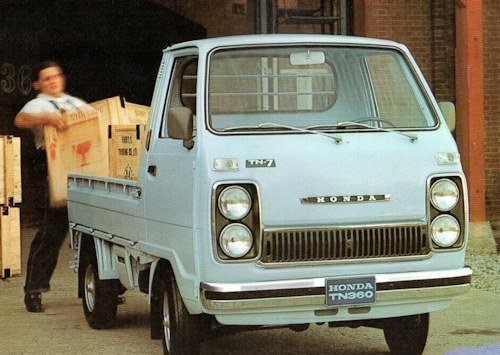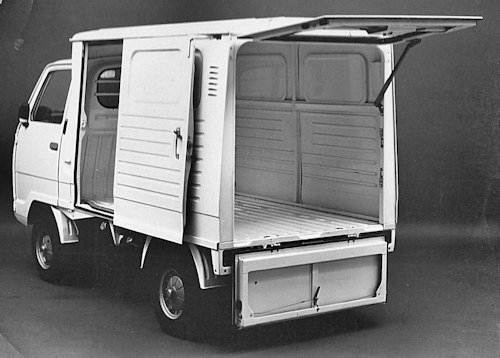Honda TN 360
 |
|
|
Manufacturer: |
Honda |
|
Production period: |
1967-1977 |
|
Previous model: |
Honda T360 |
|
Successor: |
Honda Acty |
|
designs: |
Flatbed , panel van ,minibus |
|
Engines: |
Gasoline : 0.36 liter (20-22 kW) |
|
Length: |
2990 mm |
|
Width: |
1295 mm |
|
Height: |
1595-1625 mm |
|
Wheelbase: |
1780 mm |
The Honda TN 360 with its successors in the long-running TN 360 series is a pickup truck , which first came in 1967.
History
It was first introduced to the market as a pickup truck to replace the Honda T360. The TN 360's engine was a 354cc two-cylinder air-cooled engine with an overhead camshaft derived from the Honda CB 450 motorbike. The preceding T 360 had a complicated twin-cam four-cylinder engine, however this new engine (together with the Honda N360 sedan) was better suitable for mass production. The engine was the TN 360, which was positioned under the loading floor as a mid-engine. The empty weight ranges from 500 to 555 kg.
TN 360 1967-1970
The TN 360 had its premiere in November 1967 and remained unchanged in production until January 1970. He reached the same top speed of 100 km / h as his predecessor with lower fuel consumption. Thanks to a simpler design, the weight reduction of 610 kg for the old T 360 to 500 kg on the TN 360 also helped. The performance remained unchanged at 30 hp (22 kW) at 8000 rpm, but the torque increased slightly (29 Nm) ) at 5500 / min. The TN 360 also had a much narrower turning radius of now 7.6 meters. The only body version was at the premiere of the truck called Pickup in Japan . However, after just a few months on the market, Honda added a box van in March 1968add to the offer. This was simply a pickup with a rigidly bolted body available in four different configurations (with or without side sliding doors and a roofed version) for a slightly higher price. Due to poorer aerodynamics and the slightly higher weight, the maximum speed for the van was only 90-95 km / h.
In November 1969 Honda presented an interesting variation of the TN 360, the "Snowler". This had mounted on the front wheels removable skis, while the rear wheels were replaced by caterpillars with rubber belts. The top speed of the Snowler was 45 km / h with a weight of 655 kg. The price was more than 55% higher than a regular TN 360, but only Honda offered a vehicle with this kind of capabilities at such a comparatively low price.
TN 360 III 1970-1972
The slightly facelifted Honda TN 360 III was sold at the end of January 1970. The big "H" for "Honda" remained, however, there was now a larger chrome grille, chrome bumpers, larger rear view mirrors and a slightly more comfortable interior. The 4-speed manual transmission was fully synchronized. The TN 360 III was simultaneously with the facelift of the Honda N360 and the Honda LN360 Van models introduced. In addition to the facelift, the biggest news was the addition of a Super Deluxe version, which was equipped with a radio, cigarette lighter and whitewall tires. The Snowler and van models were still available and there were now a total of 28 different models. The assortment continued to grow in July 1970, when a pickup version with solid walls and a rear tailgate instead of the three-board flap came on the market.
TN 360 V 1972-1975
The TN 360 V was introduced in June 1972. The TN 360 V received a large radiator grille and two vertically arranged headlights. The oversized "H" on the front has been replaced by the "Honda" lettering. The engine now had less compression necessary to meet the more stringent emission standards, thereby delivering only 27 hp (20 kW) at less than 7,000 rpm. The modified engine was now also able to run on unleaded gasoline thanks to a different alloy of valve guides and seats. The weight of the base model remained at 540 kg. The TN 360 V now had a driver's seatbelt standard (for passenger as an option) and the turn signals were now mounted separately from the taillights. In August 1973, the TN 360 V was again slightly changed to meet new safety standards.
TN 360 7 1975-1977
In August 1975, the TN 360 7 was introduced. The main difference to the V was that the engine could now comply with the stricter 1975 emissions regulations. Visually changed only the bumper with now black instead of dark gray side covers. The model became slightly heavier due to emissions measures at 555 kg. The seat belt on the passenger side was now also standard equipment as a previously optional electric windshield wiper. The production ended in July 1977 after about 700,000 TN 360, as Honda presented the larger Honda Acty . The TN 360 7 was the last air-cooled car to be produced in Japan.

